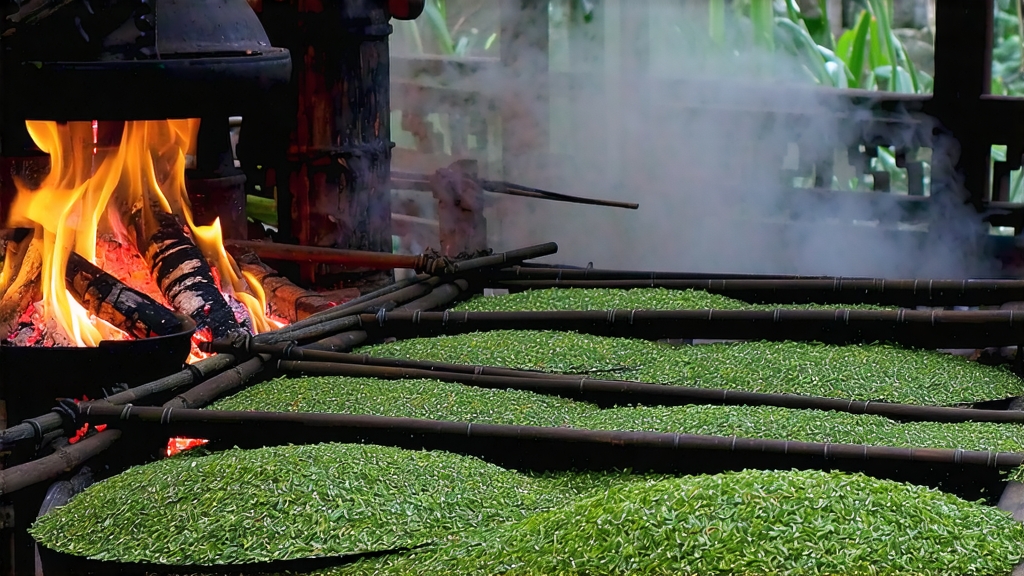
If every tea has a passport, Lapsang Souchong’s is stamped with the soot of pine needles and the salt spray of the South China Sea. Born in the rugged Wuyi Shan of northern Fujian during the late Ming dynasty, this rugged black tea was never meant to be delicate; it was engineered for travel, for the clatter of caravan hooves and the damp holds of East India clippers. Today it remains the world’s oldest recorded black tea, the prototype that taught Europe the word “bohea” and gave birth to the entire Keemun, Assam and Ceylon bloodlines. Yet inside its smoke-wreathed history lies a modern split personality: the assertive, campfire classic known in the West, and the subtle, honeyed “unsmoked” version now cherished by Chinese gourmets. Understanding both faces is the key to appreciating why a single leaf can taste like bacon, orchid or dried longan depending on who fires the final kiln.
Historical ledger books kept by the Dutch East India Company first mention “Lapsang” in 1640, only three decades after the collapse of the Ming. Local legend fills the gap with a militarized origin story: Qing troops, so the tale goes, quartered themselves in Tongmu village during harvest season. To dry the leaves before the soldiers requisitioned the withering sheds, farmers rushed the baskets over fresh pine embers, inadvertently inventing the smoke-curing process. Commerce quickly canonized the accident. By 1669 the British East India Company was auctioning “Souchong” (literally “small sort,” a grade above Pekoe) in London for prices that rivalled silver. The tea rode outbound galleons to the Atlantic colonies, where Boston patriots tipped it into the harbour dressed as Mohawks, an irony not lost on historians who note that the leaf itself had already cross-dressed as Chinese, European and finally American.
Geography is inseparable from flavour. Tongmu nestles in a granite gorge at 27° N latitude, where the Min River has carved a mist-trapping canyon only 600 m above sea level but with subtropical humidity above 85 %. The microclimate forces the indigenous Xingcun Xiaozhong cultivar to grow slowly, thickening cell walls and concentrating aromatics that can survive smoking without turning acrid. Surrounding forests of Masson pine (Pinus massoniana) supply the resinous fuel whose long flames and low ash impart the characteristic terpene profile: α-pinene, limonene and bornyl acetate, the same molecules that perfume Greek retsina and Alsatian pine-needle schnapps. EU pesticide standards now confine authentic Tongmu production to barely 2,000 mu (133 hectares) of certified gardens, making genuine village Lapsang rarer per ounce than grand cru Burgundy.
Two distinct style streams emerge from this tiny crucible. Traditional “Zhengshan Xiaozhong” is withered over pine fires, pan-fired, rolled and then hot-smoked in wooden chambers called qinglou. The smoke is generated by smouldering pine logs laid beneath slatted bamboo trays; fresh air vents are opened or closed every twenty minutes, a choreography learned by apprentices who spend two years merely tending draughts before they are allowed to touch tea. The entire firing cycle lasts eight hours, during which the leaf moisture drops from 60 % to 6 % while absorbing 0.3 % phenolic smoke compounds. The result is a glossy, jet-black strip whose dry aroma recalls creosote and sweet ham, but whose liquor surprises newcomers with a syrupy, cocoa-sweet body that balances the tar.
In the 2000s a smoke-free variant appeared to satisfy domestic demand for lighter aromatics. Called “unsmoked Lapsang” or simply “Wuyi black,” it follows the same pluck standard—one bud, two or three leaves picked in late April—but is dried with electric warm-air ovens at 70 °C. Stripped of pine, the cultivar’s native notes emerge: dried longan, lychee honey, and a cooling alpine aftertaste reminiscent of Wuyi rock oolong. Prices for top-grade unsmoked tea now exceed the smoked original by 30 % inside China, an economic inversion that would have baffled 19th-century Canton tea hongs.
Processing steps, though fewer than for oolong, are executed with martial precision. Picking starts at